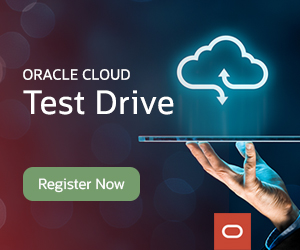Here we are at OpenWorld, where Oracle Cloud Infrastructure is taking center stage and announcing major news. Our customers want more from us as they continue to address their most significant technology challenges on our cloud, and we’re delighted to give them a long list of new capabilities.
This year we’re putting the foot on the gas in terms of onboarding new customers, deploying regions worldwide, and fine-tuning our portfolio of higher-level services that help solve complex problems easily and effectively.
Here’s a recap on all the Oracle Cloud Infrastructure goodness.
Ecosystem: Offering Major New Choices for Customers and Partners
As part of our philosophy of building an open cloud to enable customers to use the tools and software of their choice, we’ve been active on the partnership front. We’ve forged alliances with leading vendors that make our cloud platform more flexible and give customers the freedom to use what they want, without sacrifices in compatibility. Here are the highlights:
- Brand new Oracle and VMware Partnership: Customers can now run certified VMware solutions on Oracle Cloud Infrastructure. The new Oracle Cloud VMware Solution lets customers easily move VMware environments to Oracle Cloud while retaining full compatibility with VMware vCenter. Read the press release.
- Expansion of Oracle and Microsoft Partnership: In the next few quarters, Oracle is globally expanding the interconnect between Oracle Cloud and Microsoft Azure to include U.S. West, Asia, and Europe.
- Cloud Marketplace Unified Billing: We’ve enabled direct billing for third-party software on our Cloud Marketplace, where customers can use Oracle Universal Cloud Credits to purchase solutions across a wide and expanding list of partners. Read the press release.
Accelerated Global Expansion of Cloud Regions
Oracle plans to open an average of one new cloud region every 23 days over the next 15 months, adding 20 more regions (17 commercial and three government), which will bring the global footprint to 36 total regions. Eleven countries or jurisdictions will have region pairs that facilitate enterprise-class, multiregion, disaster-recovery strategies to better support those customers who want to store their data in-country or in-region.
Simplifying and Automating Cloud Security
We’ve announced a new approach to cloud security. Customers of Oracle Cloud won’t bear the burden of designing secure architectures from scratch, and will be better protected from misconfigurations than in other cloud environments. New services include:
- Oracle Maximum Security Zones: This new service provides a combination of automated preventative and detective means to enforce security controls and practices to customer-defined configurations of Oracle Cloud resources. Customers effectively lock down resources to known secure configurations, automatically prevent configuration changes, and continuously monitor and block anomalous activities.
- Oracle Cloud Guard: This new service continuously works to analyze data, automatically detect threats and misconfigurations, and then find and eliminate those security threats without requiring human oversight.
- Oracle Data Safe: A unified control center for automating database security and improving visibility into security issues with data, users, and configuration. Oracle Data Safe provides vital security controls, including monitoring database activity, discovering sensitive data, and masking databases to minimize or eliminate security risk. Available now on Oracle Cloud Infrastructure, Oracle Data Safe is included with all Oracle Database Cloud services.
Autonomous Linux
Oracle launched Autonomous Linux, which combines a cloud-optimized virtual machine image with a native cloud service called Oracle OS Management Service to help ensure higher reliability, security, and more operational efficiency at the lowest cost. Autonomous Linux is an Oracle Linux based image that performs automated patch management updates and tuning. Autonomous Linux incorporates Oracle Ksplice, which updates components and security patches without a reboot. OS Management Service complements Autonomous Linux instances with automated patch management, security, and compliance reporting and configuration management.
Flexible Infrastructure
We think that core services should be fully elastic to accommodate changing workload requirements. To enable this, we’re launching flexible models for compute and storage.
Oracle Cloud Infrastructure Next Generation Compute Platform
- Custom instances with a fully flexible compute core and memory sizing
- Scale cores up and down nondisruptively
- Scale memory up nondisruptively, and down with a restart
Oracle Cloud Infrastructure Next Generation Storage Platform
- Flexible storage capacity and performance
- Pay for massive performance or optimize for cost
- Scale storage capacity and performance up or down, nondisruptively
Free Tier: Free Oracle Cloud Services for Everyone
To help developers, educators, and IT professionals try services and build applications on Oracle Cloud, we launched new Always Free services.
A set of core resources—including two micro-compute instances, 100 GB of block storage, 10 GB each of object and archive storage, and two Autonomous Database instances, along with limited usage of APEX, SQL Developer, Monitoring, Notifications, and Email Delivery services—is available at no charge for an unlimited amount of time, and is complemented by our existing Free Trial program, which offers a broader set of services free for 30 days.
Cloud Data Platform
We announced a host of new cloud data services to augment our comprehensive portfolio of structured and unstructured data management:
- Data Science: A service for building, training, deploying, and managing machine learning models
- Data Flow: A serverless Apache Spark service for data processing at scale
- Data Catalog: A catalog service to inventory and govern data assets for easy discovery and access by other services
- Database Migration: A migration service to easily bring a wide range of databases into Oracle Cloud
- Data Integration: A data lifecycle service to extract, transform, and load data into data lakes and Oracle Autonomous Database
- Oracle MySQL service: A brand new flexible and scalable MySQL database service
- Oracle MySQL Analytics Service: An extreme-performance, real-time analytics service with in-memory capabilities that can be deployed in Oracle Cloud and on premises
- Oracle Big Data Service: A Cloudera based service for big data exploration
We’re so excited about all that we’ve accomplished during this past year, and we’re even more thrilled to see our customers build amazing things with the new services and capabilities. We encourage you to learn more about Oracle Cloud and try it for yourself.
Future Product Disclaimer
The preceding is intended to outline our general product direction. It is intended for information purposes only, and may not be incorporated into any contract. It is not a commitment to deliver any material, code, or functionality, and should not be relied upon in making purchasing decisions. The development, release, timing, and pricing of any features or functionality described for Oracle’s products may change and remains at the sole discretion of Oracle Corporation.
Forward-Looking Statements Disclaimer
Statements in this article relating to Oracle’s future plans, expectations, beliefs, and intentions are “forward-looking statements” and are subject to material risks and uncertainties. Many factors could affect Oracle’s current expectations and actual results, and could cause actual results to differ materially. A discussion of such factors and other risks that affect Oracle’s business is contained in Oracle’s Securities and Exchange Commission (SEC) filings, including Oracle’s most recent reports on Form 10-K and Form 10-Q under the heading “Risk Factors.” These filings are available on the SEC’s website or on Oracle’s website at http://www.oracle.com/investor. All information in this article is current as of September 16, 2019, and Oracle undertakes no duty to update any statement in light of new information or future events.

